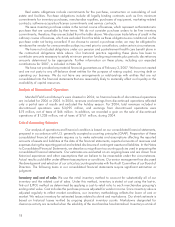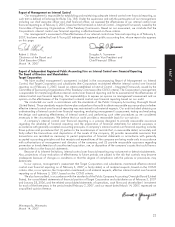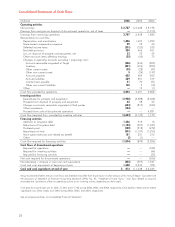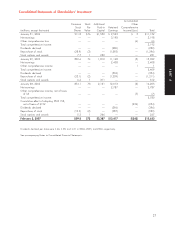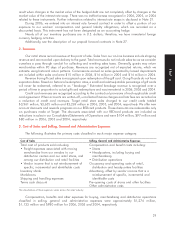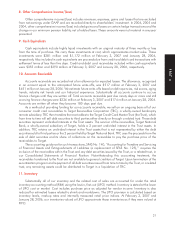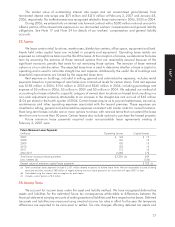Target 2006 Annual Report Download - page 46
Download and view the complete annual report
Please find page 46 of the 2006 Target annual report below. You can navigate through the pages in the report by either clicking on the pages listed below, or by using the keyword search tool below to find specific information within the annual report.Notes to Consolidated Financial Statements
1. Summary of Accounting Policies
Organization Target Corporation (the Corporation or Target) operates large-format general merchandise
and food discount stores in the United States and a fully integrated on-line business, Target.com. Our credit
card operations represent an integral component of our core retail business, strengthening the bond with
our guests, driving incremental sales and contributing meaningfully to earnings. We operate as a single
business segment.
Consolidation The consolidated financial statements include the balances of the Corporation and its
subsidiaries after elimination of intercompany balances and transactions. All material subsidiaries are
wholly-owned.
Use of estimates The preparation of our consolidated financial statements in conformity with U.S.
Generally Accepted Accounting Principles (GAAP) requires management to make estimates and
assumptions affecting reported amounts in the consolidated financial statements and accompanying notes.
Actual results may differ significantly from those estimates.
Fiscal year Our fiscal year ends on the Saturday nearest January 31. Unless otherwise stated, references to
years in this report relate to fiscal years, rather than to calendar years. Fiscal year 2006 (2006) ended
February 3, 2007 and consisted of 53 weeks. Fiscal year 2005 (2005) ended January 28, 2006 and fiscal
year 2004 (2004) ended January 29, 2005, and both consisted of 52 weeks.
Reclassifications Certain prior year amounts have been reclassified to conform to the current year
presentation.
Share-based compensation We adopted the provisions of SFAS No. 123(R), ‘‘Share-Based Payment,’’ in
2004 under the modified retrospective transition method. Therefore, all prior period financial statements
have been restated to recognize compensation cost in the amounts previously reported in the Notes to
Consolidated Financial Statements under the provisions of SFAS 123. SFAS 123(R) requires that all share-
based compensation be accounted for using a fair-value-based method.
We estimate the fair value of all share-based awards on the date of grant, which we define as the date
the award is approved by our Board of Directors or, for a limited number of awards to team members who
are not executive officers, the date the award is approved by management with appropriate delegated
authority. The majority of granted awards are nonqualified stock options that vest annually in equal amounts
over a four-year period, and all stock options have an exercise price equal to the fair market value of our
common stock on the date of grant. Generally, we recognize compensation expense for awards on a
straight-line basis over the four-year vesting period. However, in certain circumstances under our share-
based compensation plans, we allow for the vesting of team member awards to continue post-employment.
Accordingly, for awards granted subsequent to our adoption of SFAS 123(R) and to the extent the team
member meets certain age and service requirements on the date of grant, we accelerate expense
recognition such that the value of the award is fully expensed over the team member’s minimum service
period instead of over the explicit vesting period. Awards granted prior to the adoption of SFAS 123(R)
continue to be expensed over the explicit vesting period. Information related to share-based awards is
disclosed in Note 26.
Derivative financial instruments Derivative financial instruments are carried at fair value on the balance
sheet. Our derivative instruments are primarily interest rate swaps that hedge the fair value of certain debt by
effectively converting interest from a fixed rate to a floating rate. These instruments qualify for hedge
accounting, and the associated assets and liabilities are recorded in the Consolidated Statements of
Financial Position. The changes in market value of an interest rate swap, as well as the offsetting change in
market value of the hedged debt, are recognized within earnings in the current period. Ineffectiveness would
28


